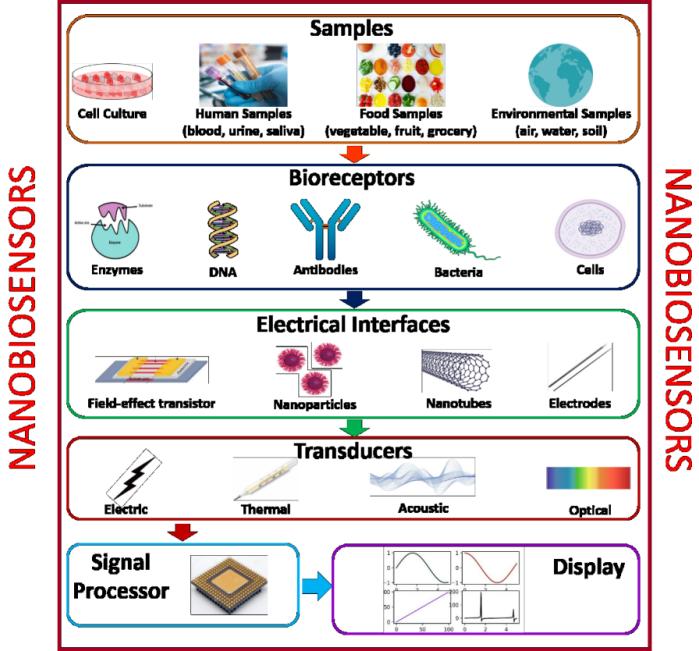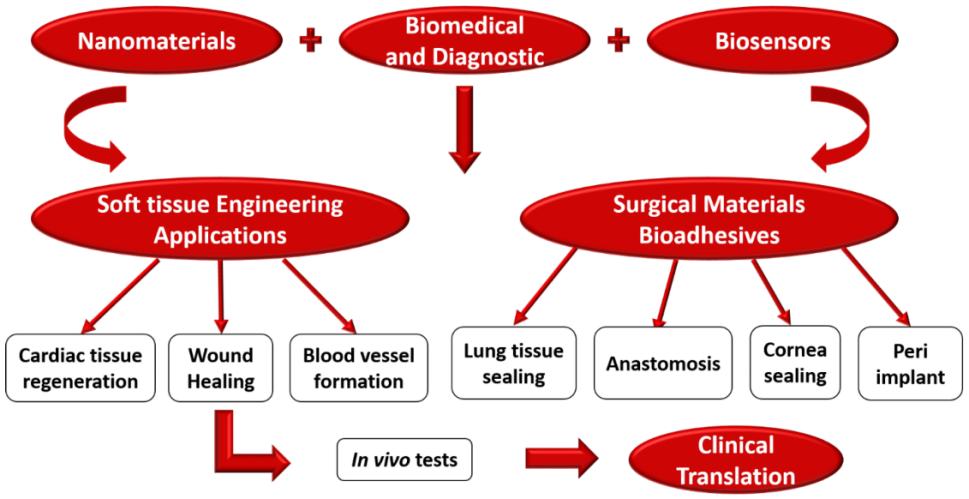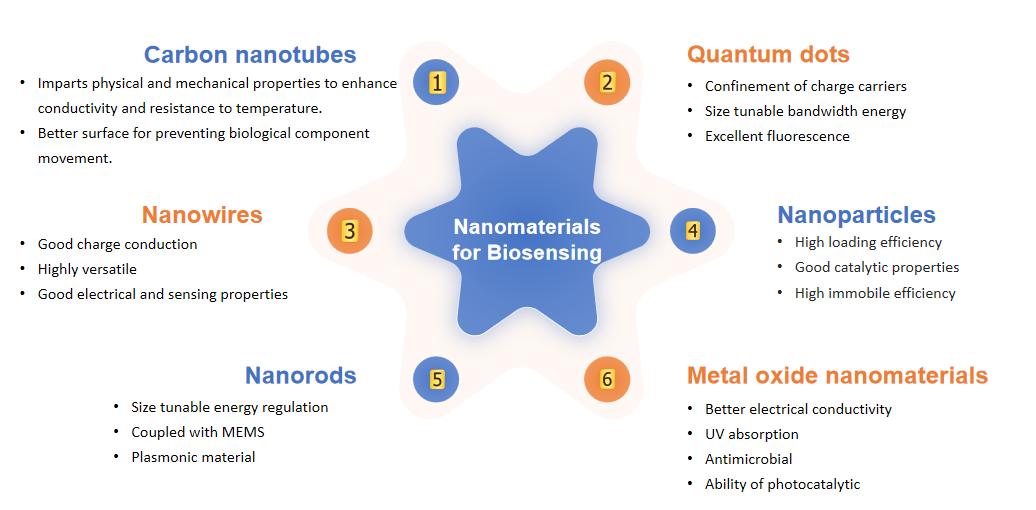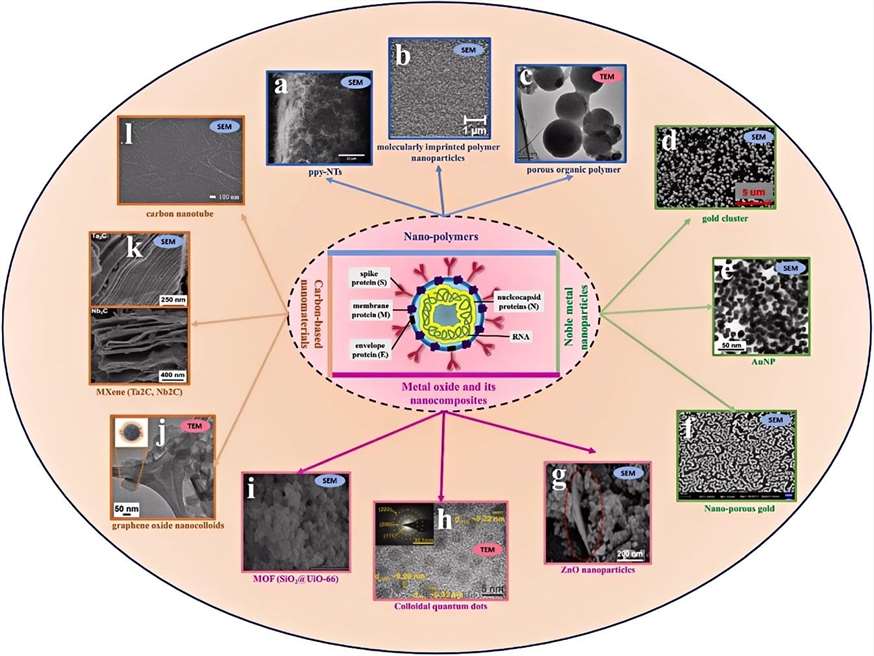Nanoformulation for Biosensor Research
Inquiry
Nanomaterial-based biosensors are widely used to detect biological materials, biological and chemical products (such as drugs, cholesterol, enzymes, blood sugar, RNA, DNA, proteins, etc.) because of the transformation of chemical or biological reactions to electrical signals. CD Formulation has highly focused on the development of novel nanoformulations for biosensors for many years. And we can offer customized personalized nanomaterials for biosensor studies.
Classification of Nanotechnology-based Biosensors
After our team has an in-depth understanding of the performance of versatile and functional nanomaterials, such as nanowires, nanorods, carbon nanotubes, quantum dots, we develop top-quality nanobiosensors to provide an outstanding platform. On this platform, we can help researchers with disease detection and disease diagnosis.
 Fig.1 Various modules of typical biosensors based on detection system, transducer, technology and bio-receptors.(Madhusudan B Kulkarni, et al. 2022)
Fig.1 Various modules of typical biosensors based on detection system, transducer, technology and bio-receptors.(Madhusudan B Kulkarni, et al. 2022)
Metal Oxide-based Biosensors
Metal oxides have unique electrical, chemical, and physical properties, exhibiting high electron movement rates. Grounded in the particular strength of metal oxides, we fabricate electrochemical nanobiosensors.
Quantum Dot-based Biosensors
Taking advantage of quantum dots, we create optical biosensors to detect organic compounds and macromolecules.
Nanowire-based Biosensors
Nanowires hold excellent mechanical, thermal, chemical, optical, and electronic properties. They are widely used to synthesize biosensors with enhanced sensing and detection limits to detect different analytes.
Nanorods-based Biosensors
Versatile nanorods are fabricated based on graphene, graphene oxide, various metal oxides, and other semiconductor materials. These nanorods play an active role in detecting nucleic acids, different carbohydrates, and metal ions.
Carbon nanotubes-based Biosensors
Our R&D center acquires a thorough understanding of the structures and performance of carbon nanotubes fabricates best-quality carbon nanotube-based biosensors for diagnostic studies.
Dendrimer-based Biosensors
Dendrimers hold well-defined structure, tunable surface functional groups, and high branching density. Our R&D center leverages dendrimers to develop unparalleled engineering biosensing platforms. These platforms have higher sensitivity, selectivity, and stability for biosensor detection.
Featured Applications of Nanobiosensors
Nanobiosensors are widely used in biomedical technology, such as tissue engineering, 3D printing, biotechnology, biomaterials, medical technology, etc.
Nanobiosensors in Disease Diagnosis
We create special nanomaterial-based biosensors that can assist in the diagnosis of diabetes, cancer, allergic reactions, and other diseases via the serum analysis.
Nanobiosensors in Cancer Diagnosis
We engineer and fabricate nanobiosensors to detect cancer biomarkers in the body, such as DNA, RNA, proteins, enzymes, and hormones released by genetic changes, supporting cancer diagnostic studies.
Nanobiosensors in Disease Detection
Nanomaterial-based biosensors hold extensive potential and value in the biodetection of serum antigens and carcinogens as well as pathogenic organisms of many metabolic disorders.
Nanobiosensors in Microorganism Detection
Nanomaterial-based biosensors have advantages such as high specificity between antigen and antibody immune responses, fluorescent labeling, and transmission of fluorescent signals along optical fibers. Nanobiosensors can be used to detect cells and microorganisms.
 Fig.2 Shows the process of nanobiosensors used for various biomedical and diagnostics applications. (Madhusudan B Kulkarni, et al. 2022)
Fig.2 Shows the process of nanobiosensors used for various biomedical and diagnostics applications. (Madhusudan B Kulkarni, et al. 2022)
Design and Optimization of Nanomaterial-based Biosensors
On our leading-edge nanotechnology platforms, we fabricate a variety of excellent nanomaterial-based biosensors by combining functional nanoparticles and biomolecules, such as peptides, proteins, and nucleic acids.
 Fig.3 Design flow chart of nanobiosensors.(AT Banigo, et al. 2020)
Fig.3 Design flow chart of nanobiosensors.(AT Banigo, et al. 2020)
Custom Novel Nanomaterials for Biosensor Studies
With the rapid development of functionalized nanomaterial fabrication techniques, nanotubes, nanowires, and quantum dots are becoming more and more frequently applied in biosensor medical diagnostic devices. We further unleash versatile nanomaterials for biosensors. And we are able to provide our outstanding customer service and assistance in the development of the nanoformulations for nanobiosensors.
Types of Nanomaterials for Biosensor Studies
Our technicians are keen on unearthing versatile nanomaterials for biosensors, such as carbon nanobubes, quantum dots, nanowires, nanoparticles, nanorods, metal oxide nanomaterials, etc.
 Fig.4 Different types of nanomaterials for biosensors. (CD Formulation)
Fig.4 Different types of nanomaterials for biosensors. (CD Formulation)
Our Fabrication Techniques of Nanomaterials for Biosensor Studies
Top-down approaches: We leverage top-down approaches (such as photolithography, laser ablation, ion milling, and chemical etching) to prepare micro/nano-process macroscopic materials to achieve the desired nanoscale.
Bottom-up approaches: In the bottom-up approaches, our most commonly used techniques are molecular beam epitaxy, physical or chemical vapor deposition and evaporation, as well as (super)molecular complexes, self-assembled monolayers and protein-polymer nanocomposites ( bio)chemical processes.
Why Choose CD Formulation?
- Have strong and world-edging nanotechnology platforms for developing nanomaterial-based biosensors.
- Have a profound knowledge of synthesizing best-quality nanomaterials based on extensive experience of bionanosensor research.
- Possess the capacity to design innovative nanorod-based biosensors, carbon nanotube-based biosensors, quantum dot-based biosensors, and dendrimer-based biosensors.
Published Data
Technology: Nanomaterial-based biosensors for SARS-CoV-2 virus detection
Journal: Nano Convergence
IF: 13.4
Published: 2024
Results:
The authors discussed the detection principles, preparation techniques, and applications for rapid detection of SARS-CoV-2 in three categories: rapid nucleic acid enhanced tests, rapid immunoassay tests, and biosensors. The authors focused on enhancing nanomaterials on biosensors to achieve rapid, sensitive, and low-cost diagnosis of the SARS-CoV-2 virus.
 Fig.5 Biological structure and of the SARS-CoV-2 and enhanced biosensor by nanomaterials. (Yang Liu, et al. 2024)
Fig.5 Biological structure and of the SARS-CoV-2 and enhanced biosensor by nanomaterials. (Yang Liu, et al. 2024)
As the advancement of nanotechnology intersects with advanced manufacturing technologies in the field of electronics, nanobiosensors, as a new type of biosensor, provide a strong guarantee for the iteration of bionanotechnology for disease diagnosis. CD Formulation keeps up with the pace of hot scientific research areas and has accumulated rich experience in designing and developing various nanobiosensors in different applications. We are able to provide researchers with personalized customized services and support for nanoformulations for biosensor research. If you are interested in our nanoformulation for biosensor research, please kindly contact us.
References
- Madhusudan B Kulkarni, Narasimha H Ayachit, Tejraj M Aminabhavi. Recent Advancements in Nanobiosensors: Current Trends, Challenges, Applications, and Future Scope. Biosensors. 2022,12(10): 892.
- AT Banigo, TO Azeez, KO Ejeta, et al. Nanobiosensors: applications in biomedical technology. IOP Conf. Ser.: Mater. Sci. Eng. 2020,805,012028.
- Yang Liu, Yilong Li, Yuteng Hang, et al. Rapid assays of SARS-CoV-2 virus and noble biosensors by nanomaterials. Nano Convergence. 2024,11:2.
How It Works
STEP 2
We'll email you to provide your quote and confirm order details if applicable.
STEP 3
Execute the project with real-time communication, and deliver the final report promptly.
Related Services

 Fig.1 Various modules of typical biosensors based on detection system, transducer, technology and bio-receptors.(Madhusudan B Kulkarni, et al. 2022)
Fig.1 Various modules of typical biosensors based on detection system, transducer, technology and bio-receptors.(Madhusudan B Kulkarni, et al. 2022)  Fig.2 Shows the process of nanobiosensors used for various biomedical and diagnostics applications. (Madhusudan B Kulkarni, et al. 2022)
Fig.2 Shows the process of nanobiosensors used for various biomedical and diagnostics applications. (Madhusudan B Kulkarni, et al. 2022)  Fig.3 Design flow chart of nanobiosensors.(AT Banigo, et al. 2020)
Fig.3 Design flow chart of nanobiosensors.(AT Banigo, et al. 2020)  Fig.4 Different types of nanomaterials for biosensors. (CD Formulation)
Fig.4 Different types of nanomaterials for biosensors. (CD Formulation)  Fig.5 Biological structure and of the SARS-CoV-2 and enhanced biosensor by nanomaterials. (Yang Liu, et al. 2024)
Fig.5 Biological structure and of the SARS-CoV-2 and enhanced biosensor by nanomaterials. (Yang Liu, et al. 2024) 
